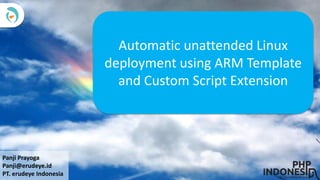Panji automatic unattended linux deployment using arm template and custom script extension
Editor's Notes
- #3: The infrastructure for your application is typically made up of many components ŌĆō maybe a virtual machine, storage account, and virtual network, or a web app, database, database server, and 3rd party services. You do not see these components as separate entities, instead you see them as related and interdependent parts of a single entity. You want to deploy, manage, and monitor them as a group. Azure Resource Manager enables you to work with the resources in your solution as a group. You can deploy, update or delete all of the resources for your solution in a single, coordinated operation. You use a template for deployment and that template can work for different environments such as testing, staging and production. Resource Manager provides security, auditing, and tagging features to help you manage your resources after deployment. The benefits of using Resource Manager Resource Manager provides several benefits: You can deploy, manage, and monitor all of the resources for your solution as a group, rather than handling these resources individually. You can repeatedly deploy your solution throughout the development lifecycle and have confidence your resources are deployed in a consistent state. You can use declarative templates to define your deployment. You can define the dependencies between resources so they are deployed in the correct order. You can apply access control to all services in your resource group because Role-Based Access Control (RBAC) is natively integrated into the management platform. You can apply tags to resources to logically organize all of the resources in your subscription. You can clarify billing for your organization by viewing the rolled-up costs for the entire group or for a group of resources sharing the same tag.












